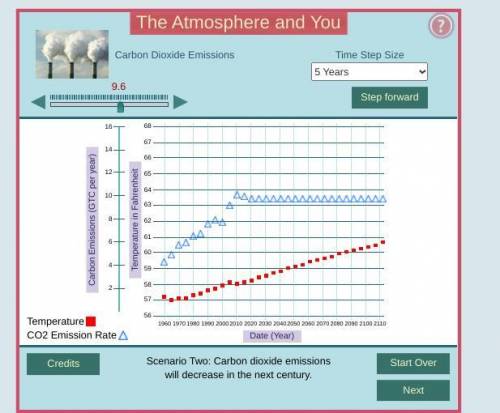
The Atmosphere and You Lab Report
Instructions: Record your observations in the lab report below. You will submit your completed report.
Name and Title
Include your name, instructor's name, date, and name of lab.
Name:
Instructor Name:
Date : Tue, Dec 8 2020
Name of lab: Greenhouse Effect
Objective(s)
In your own words, what was the purpose of the lab? I will find out how human activities add extra greenhouse gases to the atmosphere.
Hypothesis
In this section, please include the if/then statements you developed during your lab activity. These statements reflect your predicted outcomes for the experiment.
Procedure
Complete your hypothesis (above).
I think that Carbon dioxide emissions will stay the same in the next century and global temperatures will increase.
.
Identify the independent (test) variable and the dependent (outcome) variable: _
Practice using the computer model. Select each marker to see what it does. Here is a summary you can refer back to as you complete your experiment.
Carbon Dioxide Emissions Slider: You will use the arrows to change the amounts of carbon emissions.
Time Step Size: This will allow you to view the data every 5 years or every 10 years.
Start Over: Use this to reset the model if needed.
The current carbon emissions are 9.8 gigatons, or 9.8 billion tons. Complete all three scenarios to find out what happens to the global temperature if these emissions stay the same, decrease, or increase over the next century. Follow the instructions in the Data section of this report.
Data
For each scenario, record the carbon dioxide emission rate and the global temperature. The data for the years 1960–2010 are already filled out for you.
Scenario One: Carbon dioxide emissions stay the same
Set the carbon dioxide emissions rate to 9.8 gigatons.
Set the time step size to 10 years.
Select step forward until you have the data through the year 2110.
Record the data in the table below.
Year
Carbon Emissions (gigatons)
Temperature (Fahrenheit)
1960
4.2
57.2
1970
5.8
57
1980
6.2
57.4
1990
7.8
57.6
2000
8
58
2010
9.8
58
Maintain carbon dioxide emissions at 9.8 for the rest of scenario one.
2020
2030
2040
2050
2060
2070
2080
2090
2100
2110
Scenario Two: Carbon dioxide emissions decrease
Set the carbon dioxide emissions rate to 9.8 gigatons.
Set the time step size to 10 years.
Select the step forward button once.
Decrease the carbon dioxide emissions by 0.2 and press step forward.
Continue stepping forward once, decreasing the carbon emissions each time, until you reach 2110.
Record the data in the table below.
Year
Carbon Emissions (gigatons)
Temperature (Fahrenheit)
1960
4.2
57.2
1970
5.8
57
1980
6.2
57.4
1990
7.8
57.6
2000
8
58
2010
9.8
58
Decrease carbon dioxide emissions by 0.2 each step forward for the rest of scenario two.
2020
2030
2040
2050
2060
2070
2080
2090
2100
2110
Scenario Three: Carbon dioxide emissions increase
Set the carbon dioxide emissions rate to 9.8 gigatons.
Set the time step size to 10 years.
Select the step forward button once.
Increase the carbon dioxide emissions by 0.2 and press step forward.
Continue stepping forward once, increasing the carbon emissions each time, until you reach 2110.
Record the data in the table below.
Year
Carbon Emissions (gigatons)
Temperature (Fahrenheit)
1960
4.2
57.2
1970
5.8
57
1980
6.2
57.4
1990
7.8
57.6
2000
8
58
2010
9.8
58
Increase carbon dioxide emissions by 0.2 for each step forward for the rest of scenario three.
2020
2030
2040
2050
2060
2070
2080
2090
2100
2110
Conclusion
Use your data to answer the following questions. Use complete sentences, and be as detailed as possible.
Summarize how the carbon emissions affected the atmospheric temperature in each of the three scenarios:
Scenario One:
Scenario Two:
Scenario Three:
Was your hypothesis supported by your results or not? Explain how you know.
Explain the difference between the greenhouse effect and global warming.
Based on your knowledge of how the greenhouse effect works, why does the level of carbon dioxide affect the global temperature?
Name three sources of atmospheric carbon dioxide.



Answers: 2
Another question on Physics

Physics, 22.06.2019 11:50
Amoving electron has kinetic energy k1. after a net amount of work w has been done on it, the electron is moving one-quarter as fast in the opposite direction. (a) find w in terms of k1. (b) does your answer depend on the final direction of the electron's motion?
Answers: 2

Physics, 22.06.2019 14:00
Me pl give an example of a collision in real life. use the law of conservation of energy to describe the transfer of momentum. be sure and discuss the momentum before and after the collision occurs. you will need at least 3 sentences to thoroughly answer this question.
Answers: 3


You know the right answer?
The Atmosphere and You Lab Report
Instructions: Record your observations in the lab report below. Y...
Questions

Physics, 22.06.2019 16:30

Mathematics, 22.06.2019 16:30


Mathematics, 22.06.2019 16:30



History, 22.06.2019 16:30


History, 22.06.2019 16:30

Mathematics, 22.06.2019 16:30

History, 22.06.2019 16:30



Social Studies, 22.06.2019 16:30

English, 22.06.2019 16:30

English, 22.06.2019 16:30

Social Studies, 22.06.2019 16:30


Mathematics, 22.06.2019 16:30




